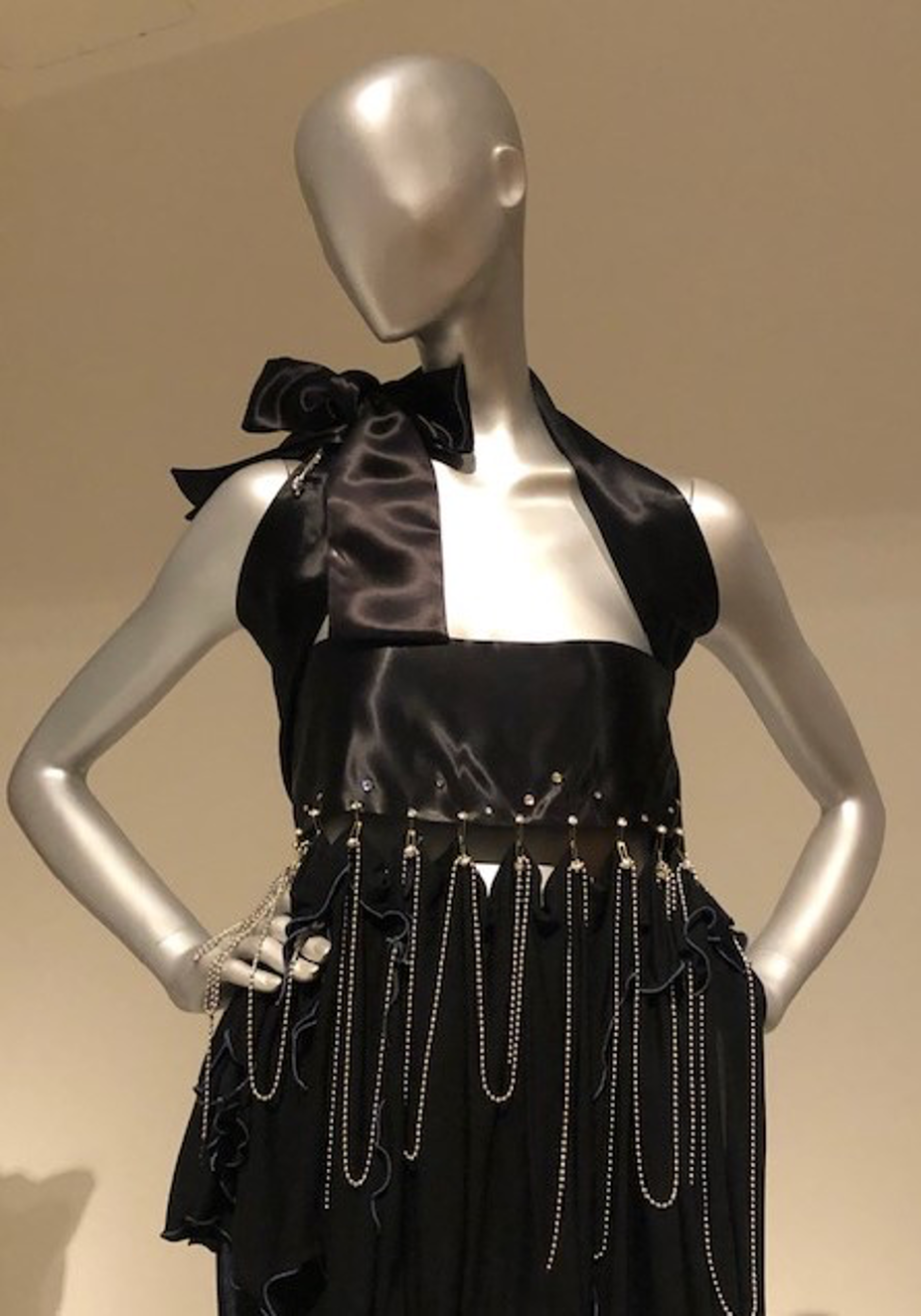A Second Visit to “Made It: The Women Who Revolutionized Fashion”
With COSMOS Selects for Best in Show
Peabody Essex Museum, through March 14, 2021
The current exhibition at Peabody Essex Museum, Made It: The Women Who Revolutionized Fashion, is worthy of a second look. That is, if you can take the time to enter more deeply into the layers and folds of an unusually disparate display of costumes, selected over centuries from 84 American and European designers. For COSMOS, the first visit to the exhibition coasted along the revolutionary and feminist themes, with the concluding gallery of outspoken T-shirts. But a return to the exhibit offered another reason to see, and appraise, such an eclectic collection of women’s clothing.


The show, which opened in November 2020, kicks off with an ornate Mantua gown of 1760, seemingly constructed on a scaffold for the 6-foot-wide dress, and then continues through the revealing sportswear so common in 2018. The 100 or so outfits were selected from the costume collections of Peabody Essex Museum and co-curator Kuntsmuseum Den Haag, as well as from other institutional and private collectors.
The revolutionary theme of the Made It exhibition embraces designers who Made It while Making their original creations of their trade. A clothing designer is a de facto innovator. That is what they do. They continuously pursue a changing design aesthetic, reaching for the New, Forward, Stylish, Trendsetting next thing. Sometimes shocking. Sometimes simply practical. But fashion must exist on a wave of constant change or it is not fashion. As Diana Vreeland once said, “The Eye Has to Travel”.
But is fashion truly a revolutionary act? Are there any epic changes that radically transform lives and lifestyles, permanently?
The feminist movement itself has never been aligned with the fashion world, even though the clothing industry became one of the first where women succeeded and succeeded very nicely. Frequently designers become entrepreneurs who also own their companies. The Made It exhibition features many such designer/entrepreneurs, including Donna Karan, Rei Kawakubo, Sonia Rykiel, and Carolina Herrera. They create the aesthetic brand and deal with the immense complications of running a manufacturing business which can be mortally wounded by a “bad season”.
A Revolutionary with Scissors
From the COSMOS point of view, one designer stands revolutionary head and Straw Hat above all others. She forever altered the silhouette of style. On both aesthetic and practical influences, she created the new look for the modern women who was ready for the un-corseted lifestyle.
Learning to sew at a Catholic orphanage, where she and her sisters were dispatched by an itinerant father after the loss of their mother, Coco Chanel stepped into the world as a solitary young woman possessed with only an ability to sew, a will to survive and an incredible, innate sense of style. But survival and entrepreneurial acumen go hand in hand. As does boldness. And whether it was her youthful attitude or a higher vision, she made the initial strike against the corset and its suffocating 20inch requirement for a waist. After some success with her first millinery shop, she was emboldened to make revolution with a new shop in Deauville, France. To stock her new shop, she purchased bolts of jersey, then used for men’s undergarments, and stitched up the world’s first loosely constructed sportswear for women. And the ladies flocked to the shop, as recreational wear was invented and mobility released from bondage.
She was an innovator who innovated her entire life. Coco Chanel invented trouser dressing, the little black dress, the professional suit, costume jewelry, black and white aesthetics, the jaunty hat. She even invented designer perfume. Was she a feminist and revolutionary? These were not terms in her vocabulary. But innovation can be revolutionary.
A Second Visit to Made It
On our second visit to Made It , and with an education in fashion design from Parson’s School of Design, COSMOS asked this question: Which designs are enduring? Why have some garments aged well, and could be worn today, with perhaps an adjustment of hem length or choice of fabric? And why have other pieces lost their allure, and even their original panache? But that is the harsh reality of fashion, it is a business of transient tastes.
COSMOS Selects
Because it is commerce as well as art, fashion gets rated. The journalists and media continuously inform on the trends and the rejects. Even more demanding, are the Best and Worst Lists which can deliver canonization or ridicule with one mention. Oddly, it is almost impossible to not judge fashion. Some force of discrimination is playing out in the psyche. Wear one dress and attract the mate but wear another and be forever forgotten….?
The Made It exhibition offers a particularly unusual selection of competing fashions, spanning centuries of convention, trends, lifestyles. And among these 84 designers and typically 1 or 2 pieces, which garments still pass scrutiny in the current aesthetic?
As we wondered through the many mannequin stages of the exhibition, we looked for the immortals. Styles that could endure beyond their original time of creation. Aesthetics, craftsmanship, some flattery of figure, essentials of design harmony. The elusive factor of good taste. The elusive other factor of eternally cool. And wearable.
COSMOS finally settled on 10 designers for COSMOS SELECT ENDURING DESIGNERS, who have achieved a momentary elevation from fashion to timeless design. (Coco Chanel excused from rankings as achieved supernova status.) The year cited in the list is year of piece exhibited in the show . The second group of COSMOS SELECT SCULPTURE CLASSICS are works of beauty but exist in a purely aesthetic niche, no wearable ranking as required for Enduring Designers.
COSMOS SELECT ENDURING DESIGNERS
2011 — Isabel Toledo
1972 — Sonia Rykiel
1930 — Valentina
1925 — The Callot Sisters
1977 — Zandra Rhodes
1937 — Maggy Rouff
1930s — Sally Milgrim
1989 — Ann Demeulemeester
1984 — Anne-Marie Beretta
1985 — Donna Karan
Blog photos shown in order of listing.
COSMOS SELECT SCULPTURE CLASSICS
1970-2014 — Rei Kawakubo
2018 — Iris Van Herpen
2018 — Jamie Okuma
1967 — Alice Edeling
1875 — Maria Theresa Baldwin Hollander
1861 — Elizabeth Keckley










